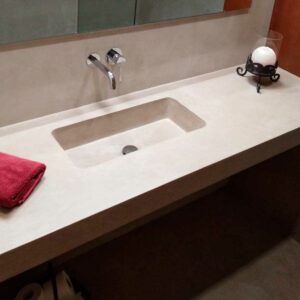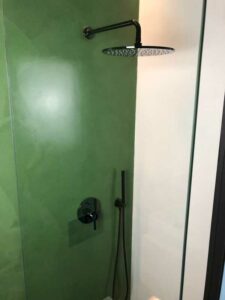
Microcement Surfaces
Microcement Surfaces Surfaces to be applied Microcement We can apply microcement to almost any surface we can think of: plasterboard, tile, brick, tiles, plaster, cement
Sanding microcement is one of the most critical steps in its application process. While every stage in the application is important, sanding each layer—from the tile grouting (if present) to the base and finish coats—is essential to achieving a flawless result.
Choosing the right sandpaper is crucial for two reasons:
To prevent discoloration of the microcement, especially in lighter colors.
To effectively work on the hard surface of the material.
Using high-quality sandpaper ensures a precise finish, as the final result depends significantly on this choice.
The grain size of the sandpaper must correspond to the granulometry of the microcement layer. For base coats, a 40-grain sandpaper is typically used, while fine microcement layers require a 220-grain sandpaper. The grain should also be selected based on whether sanding will be done manually or with an orbital machine, as this affects the outcome

Sanding should always be performed with control to avoid removing too much material and exposing previous layers. Maintaining the minimum thickness of each layer is essential, and only superficial abrasion should be applied. The process usually involves circular motions, using one hand to feel for irregularities and sanding until they are minimized.
Sanding must only be carried out when the layers are completely dry. Attempting to sand wet microcement can damage the surface. Additionally, the trowel application of each layer plays a vital role in the sanding process. A smoother application reduces the time needed for sanding and minimizes imperfections.
After sanding, it is essential to use a vacuum cleaner to eliminate any residual dust on the surface. This prevents adhesion problems between layers and ensures the next steps proceed without issues.
In professional microcement applications, careful attention is given to each step to ensure a perfect finish. The experience and precision applied during the process guarantee superior results in every detail.
For more information, visit the CimentStudio website and discover how expertise transforms spaces with microcement.

Microcement Surfaces Surfaces to be applied Microcement We can apply microcement to almost any surface we can think of: plasterboard, tile, brick, tiles, plaster, cement

Microcement Price Microcement Cost What is the price of Microcement? It is the most repeated question lately by many people when they hear about microcement.

Microcement Square Meter Price Microcement Square Meter Price What is the price per square meter of the microcement? This is the question that all our